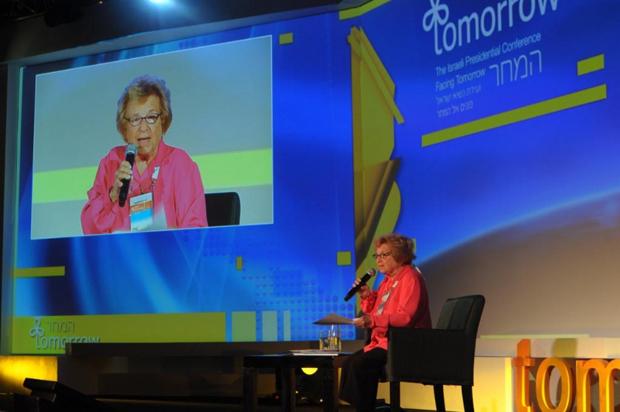At the Israeli Presidential Conference: from Dr. Ruth to Peter Beinart
Published June 21, 2012
REPORTER’S NOTEBOOK
JERUSALEM (JTA) – What do hip-hop mogul Russell Simmons, Google Chairman Eric Schmidt, Zionist critic Peter Beinart and Dr. Ruth have in common?
ADVERTISEMENT
If you’re still puzzling over that one, you’re not alone. So are the participants at this year’s 2012 Israeli Presidential Conference, which featured those four among dozens of other panelists at the confab held this week in Jerusalem.
Titled “Facing Tomorrow,” the conference assembled leading entrepreneurs, politicians, academics and Jewish community figures from around the world, and with them a bevy of publicists, journalists and myriad other hangers-on.
There was Dr. Ruth Westheimer, the octogenarian sexologist, opening the conference in a one-on-one, center-stage discussion with Israeli technology investor and entrepreneur Yossi Vardi. There was Terje Roed-Larsen, the Norwegian U.N. diplomat who played a key role in the Oslo Accords and now heads the International Peace Institute, looking lost in the exhibit hall. In a corner near the bar, Noam Shalit, father of freed captive Israeli soldier Gilad Shalit, chatted with Malcolm Hoenlein, the executive vice chairman of the Conference of Presidents of Major American Jewish Organizations. Stuck in the crowd, Alexander Mashkevich, the Kazakh-Israeli minerals oligarch and one of the conference’s benefactors, smiled politely amid a scowling coterie of thuggish men wearing shiny white suits.
It was a conference of bold-faced names without a coherent theme. Some sessions focused on Israel’s strategic threats and Jewish identity. Others were about the future of smartphones and cloud computing. A group of neuroscientists led a discussion on how machines can help the brain. Israeli President Shimon Peres, the conference’s host, held a public work meeting with the president of Croatia.
Some of the first-timers among the 4,000 or so attendees — an overwhelmingly but not exclusively Jewish group — weren’t quite sure what to make of it.
ADVERTISEMENT
“I’m trying to figure out what the conference is even about,” said Dov Waxman, a professor from the City University of New York who blogs on the Daily Beast and is writing a book about Jewish politics. “What is the purpose of this? Is it to pontificate about the Jewish future? It’s like a schmooze-fest, I think.”
Indeed, perhaps more than anything else, the conference, now in its fourth year, aspires to be a sort of Jewish Davos – a gathering where the A-listers of the Jewish world can meet, network, exchange ideas and maybe have a good time. Except unlike the exclusive Davos World Economic Forum, it’s a lot easier to get in and there’s no registration fee.
The conference is a testament to the star power and vision of Peres. Its $2.7 million price tag is paid for largely by the 88-year-old president’s friends and associates, including corporate and philanthropic sponsors, and its theme is something that Israeli politicians, at least, are not known for thinking too much about: the long-term future.
If it is to become a fixture on the annual Jewish conference calendar, the Israeli Presidential Conference will be the only real multidisciplinary one. What other Jewish forum brings together the likes of Cisco’s CEO, Israeli singer-songwriter Achinoam Nini (aka Noa), Henry Kissinger, Paralympics swimmer Keren Leibovitch, Obama administration adviser Dennis Ross, Bank of Israel Governor Stanley Fischer, Quartet Middle East envoy Tony Blair and Israeli filmmaker Joseph Cedar?
Where else can you go from a session in which Cisco Chairman John Chambers talks about the future of data on the Internet to a talk by Nobel laureate Daniel Kahneman, a Princeton University psychologist, about the inherent advantage hawks have over doves in political arguments? Or from a discourse by Leon Wieseltier, the literary editor of The New Republic, about the need for Israel to earn the conditional love of American Jews, to one in which Dr. Ruth offers tips about female orgasms?
The Israeli Presidential Conference is deliberately eclectic, while the Jewish world’s other major annual gatherings are focused. The biggest Jewish conference of the year — the springtime gathering in Washington of the American Israel Public Affairs Committee, which for two years running has drawn more than 10,000 people — is about U.S.-Israel politics. The annual General Assembly of the Jewish Federations of North America, which a decade ago drew crowds similar to AIPAC at the time – about 3,000 – is mostly about Jewish communal service and hasn’t grown in 10 years. The Reform movement’s biennial (6,000 attendees this year) and the annual Chabad-Lubavitch shluchim conference (4,000 attendees) are limited to specific religious denominations.
The Presidential Conference was about a lot of different things, with a heavy dose of politics and technology.
“I think it’s great to be at a conference that’s a crossroads of significant policymaking Jews from around the world with different political, religious and cultural backgrounds,” said Steven M. Cohen, director of the Berman Jewish Policy Archive at New York University’s Wagner School.
The conference is also unusual for Israel. Most presenters spoke in English, even the Israelis, and there were more suits and ties than some Israelis see in a lifetime.
Every time Peres entered a room, he was given a rousing ovation. On opening night, Peres bestowed Israel’s first-ever presidential medal on Kissinger, calling him a “brother” and hailing “the tremendous effort you made to help us on every occasion as a great statesman and as a great Jew.”
No mention was made of the revelation two years ago on then-released Nixon tapes on which Kissinger could be heard telling the U.S. president in 1973 that it was not a U.S. concern if the Soviet Union decided to put the Jews in gas chambers. Kissinger later apologized for the remark.
One notable absence from the conference was Israeli Prime Minister Benjamin Netanyahu, who canceled his appearance due to a leg injury suffered during a soccer game a few days earlier.
















